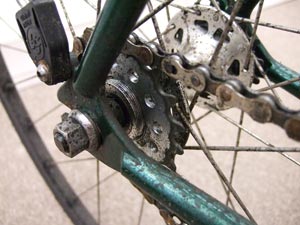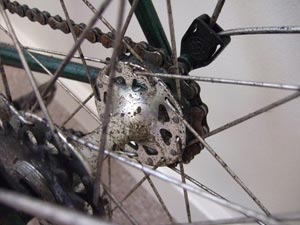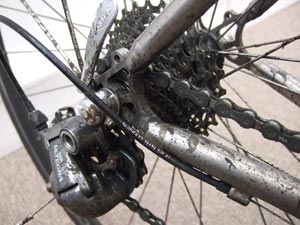 |
 |
 |
Reasons to ride fixed wheel are, at this time of year, many and varied, but the most obvious starts covering the transmission the moment you leave your front door. A month of freezing weather with little if any rain to wash them clean has left the roads coated in a foul, grey, gritty, slippery, salty muck that not only besmirches the paintwork but attacks metal parts with gusto.
Delicate derailleur mechanisms and lightweight cassettes might almost have been designed to accumulate this clag in their many little corners; jockey wheels, sprockets, control cables and chain all start to suffer from wear and corrosion unless cleaned scrupulously and frequently.
Compare this with the simplicity of a fixed transmission, which, with just one sprocket, a chain running in a straight line and no control cables has but one wear interface, where the chain runs onto the sprocket. It also lessens reliance on and use of the rear brake, which means longer-lasting rim and brake blocks. Not only does a fixed wheeler need less frequent cleaning, but cleaning it is so quick and easy it can be done more often…
Then there’s bike control on roads that might as well be covered in ball bearings; having the pedals connected directly to the back wheel offers much more precise control over rear wheel rotation – and therefore braking in hazardous conditions – than does a freewheel.
Descending a long hill is no longer a question of enduring an icy blast that quickly removes warmth from the knees and leg muscles. Instead, the legs have to keep working – hard – while speed is inevitably low, so there’s never a chance to get chilled.
And then there’s the training effect. Fixed may not be the only way or even the best way to get fit on a bike, but it does impose some useful challenges. One is the need to find a high cadence for riding on the flat provided the gear is well-chosen. Find yourself pushing along on ever-bigger gears, and a few sessions on fixed are the perfect way to break out of the vicious circle.
Fixed wheel also counts for more than riding with gears and a freewheel. A two-hour training ride with no chance to rest the legs feels like three hours of ‘normal’ riding, making it a great choice for the time-poor. Why? Hills, of course. Up or down, they make life hard for the fixed rider and virtually guarantee a real improvement in strength and technique. Which has to be a good thing, surely?




